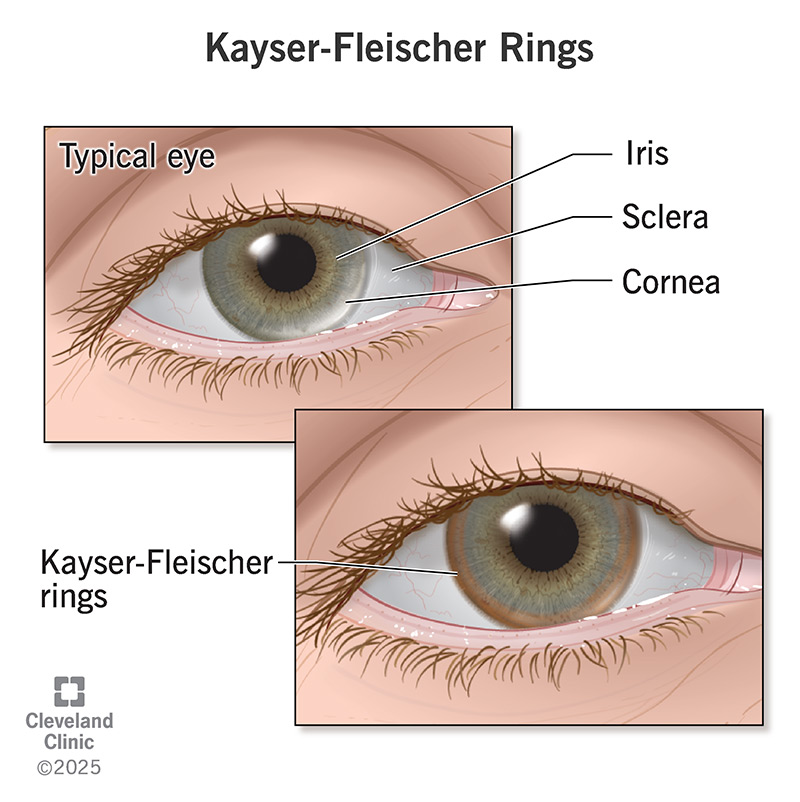Kayser-Fleischer rings are dark circles that form around the colored parts of your eye (your irises). They can happen if you have Wilson’s disease or another liver condition that causes copper to build up in your body. The rings are usually harmless, but you’ll need medications to treat the condition that caused them.
Advertisement
Cleveland Clinic is a non-profit academic medical center. Advertising on our site helps support our mission. We do not endorse non-Cleveland Clinic products or services. Policy

Kayser-Fleischer (KF) rings are dark circles that form on the inner surface of the cornea in your eye. They’re made of copper deposits that travel through your bloodstream and settle in your eye.
Advertisement
Cleveland Clinic is a non-profit academic medical center. Advertising on our site helps support our mission. We do not endorse non-Cleveland Clinic products or services. Policy
Usually, you won’t even know you have Kayser-Fleischer rings. An eye doctor will see and diagnose them during your regular eye exam. But you might be able to see one in the mirror or by taking a photo of your eye if the copper buildup is heavy enough. It’s harder to see Kayser-Fleischer rings in darker eyes. The copper deposits stand out more in lighter-colored eyes.
KF rings can look like a brown, green or gold circle around the colored part of your eye (iris). They form in your peripheral cornea. This is where your cornea meets the white part of your eye (sclera). The color starts as an arc over the top and bottom of your eye. Eventually, it will spread and connect to form a ring around your peripheral cornea.
The copper deposits in your eyes are usually harmless. But the conditions that cause Kayser-Fleischer rings can damage other parts of your body if they’re not treated.
The most common cause of Kayser-Fleischer rings is Wilson’s disease. It causes copper to build up in your body. The excess copper clumps together and can form Kayser-Fleischer rings.
Wilson’s disease is almost always the cause of KF rings. It’s rare, but some other conditions can cause them, including:
Advertisement
A healthcare provider won’t treat Kayser-Fleischer rings directly. Instead, they’ll suggest treatments for the cause.
There are two main Wilson’s disease treatments:
Your provider may suggest prescription medications to manage primary biliary cholangitis. Babies born with neonatal cholestasis may need to eat special formulas and take medications.
When you treat the condition behind the copper buildup, the KF rings fade away.
You can’t prevent Kayser-Fleischer rings because you can’t prevent the conditions that cause them.
Talk to a healthcare provider if you know that immediate family members (your biological parents, siblings or children) have Wilson’s disease. Your provider might recommend screening. Diagnosing and treating Wilson’s disease before it causes a copper buildup in your body can prevent symptoms like KF rings.
Visit an eye doctor if you notice any changes in how your eyes look or feel. Kayser-Fleischer rings won’t affect your vision or cause any other symptoms. But it’s important to get them diagnosed so you can treat the cause.
There’s a good chance you won’t know you have Kayser-Fleischer rings until your eye doctor tells you during an eye exam. It might sound dangerous to think about bits of copper stuck inside your eye. Fortunately, the rings are usually harmless. But Wilson’s disease and other conditions that cause KF rings need treatment.
Talk to your healthcare provider about managing the copper buildup. They’ll tell you how you can reduce it, and what you’ll need to know to protect your eyes, liver and the rest of your body in the future.
Advertisement
Cleveland Clinic’s ophthalmologists and optometrists have the highest training available. We provide exams, vision correction and care for many eye conditions.

Last reviewed on 10/22/2025.
Learn more about the Health Library and our editorial process.